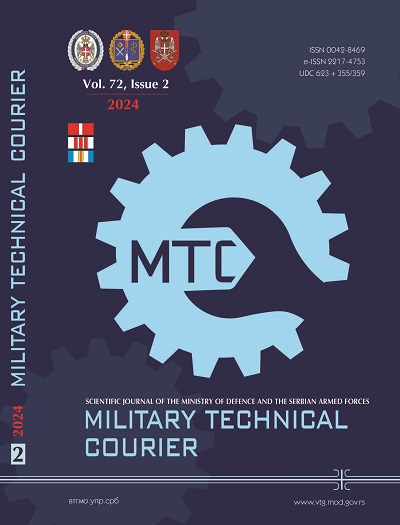Experimental study of the mechanical behavior of dam sediment renforced by geotextiles and geogrids
Abstract
Introduction/purpose: Geosynthetic materials have been successfully used for soil reinforcement to improve bearing capacity. In this article, geotextiles are used as tension material for the reinforcement of a mixture based on dredged sediment from the Cheurfas dam (Mascara) and quarry sand.
Methods: Immediate bearing index tests were carried out in the laboratory to study the mixing behaviour, and the three-point bending flexural test was carried out on prismatic specimens to study the traction capacity of the mixture. Mixture samples are selected and tested without reinforcement. Then, by placing one, two and three layers of geotextile at a certain depth of the sample, the effects of a number of layers and type of geotextile and geogrid on increasing the bearing capacity of the mixture are discussed.
Results: The results of these tests show that the bearing capacity of the samples reinforced by geotextile and geogrid is increased compared to that of the unreinforced samples. Based on the results obtained from Proctor-IPI, their values do not permit the movement of construction machinery during the construction of pavement layers.The Immediate Bearing Index values are found sufficient for pavement layers. Geotextile introduction increases traction strength and improves stress distribution on soil samples, with the effect being significant for woven geotextile blends.
Conclusion: All things considered, the results point to the possibility of using reinforced local soils as an affordable and practical option for building pavements. To guarantee long-term performance and optimise building methods, more research is advised.
References
Bergado, D.T., Youwai, S., Hai, C.N. & Voottipruex, P. 2001. Interaction of nonwoven needle-punched geotextiles under axisymmetric loading conditions. Geotextiles and Geomembranes, 19(5), pp.299-328. Available at: https://doi.org/10.1016/S0266-1144(01)00010-3.
Bourabah, M.A., Abou-Bekr, N. & Taibi, S. 2010. Geotechnical Characterization of Dredging Sediments for Valorization in Road Embankments: Case of the Cheurfas Dam (Algeria). In: GeoFlorida 2010: Advances in Analysis, Modeling & Design, West Palm Beach, Fl, USA, February 20-24. Available at: https://doi.org/10.1061/41095(365)224.
Duncan-Williams, E.D. & Attoh-Okine, N.O. 2008. Effect of geogrid in granular base strength – An experimental investigation. Construction and Building Materials, 22(11), pp.2180-2184. Available at: https://doi.org/10.1016/j.conbuildmat.2007.08.008.
Fannin, R.J. & Sigurdsson, O. 1996. Field Observations on Stabilization of Unpaved Roads with Geosynthetics. Journal of Geotechnical Engineering, 122(7), pp.544-553. Available at: https://doi.org/10.1061/(ASCE)0733-9410(1996)122:7(544).
Haeri, S.M., Noorzad, R. & Oskoorouchi, A.M. 2000. Effect of geotextile reinforcement on the mechanical behavior of sands. Geotextiles and Geomembranes, 18(6), pp.385-402. Available at: https://doi.org/10.1016/S0266-1144(00)00005-4.
Madhavi Latha, G. & Murthy, V.S. 2007. Effects of reinforcement form on the behavior of geosynthetic reinforced sand. Geotextiles and Geomembranes, 25(1), pp.23-32. Available at: https://doi.org/10.1016/j.geotexmem.2006.09.002.
Michalowski, R.L. 2004. Limit Loads on Reinforced Foundation Soils. Journal of Geotechnical and Geoenvironmental Engineering, 130(4), pp.381-390. Available at: https://doi.org/10.1061/(ASCE)1090-0241(2004)130:4(381).
Park, T. & Tan, S.A. 2005. Enhanced performance of reinforced soil walls by the inclusion of short fiber. Geotextiles and Geomembranes, 23(4), pp.348-361. Available at: https://doi.org/10.1016/j.geotexmem.2004.12.002
Patra, C.R., Das, B.M. & Atalar, C. 2005. Bearing capacity of embedded strip foundation on geogrid-reinforced sand. Geotextiles and Geomembranes, 23(5), pp.454-462. Available at: https://doi.org/10.1016/j.geotexmem.2005.02.001.
Raymond, G. & Ismail, I. 2003. The effect of geogrid reinforcement on unbound aggregates. Geotextiles and Geomembranes, 21(6), pp.355-380. Available at: https://doi.org/10.1016/S0266-1144(03)00044-X.
Resl, S. & Werner, G. 1986. The influence of nonwoven needle-punched geotextiles on the ultimate bearing capacity of the subgrade. In: 3rd International Conference on Geotextiles, Vienna, Austria, pp.129-133, April 07-11 [online]. Available at: https://library.geosyntheticssociety.org/proceedings/1-c-06-the-influence-of-nonwoven-needlepunched-geotextiles-on-the-ultimate-bearing-capacity-of-the-subgrade-pdf-2/ [Accessed: 20 December 2023].
Varuso, R.J., Grieshaber, J.B. & Nataraj, M.S. 2005. Geosynthetic reinforced levee test section on soft normally consolidated clays. Geotextiles and Geomembranes, 23(4), pp.362-383. Available at: https://doi.org/10.1016/j.geotexmem.2004.11.001.
Yetimoglu, T. & Salbas, O. 2003. A study on shear strength of sands reinforced with randomly distributed discrete fibers. Geotextiles and Geomembranes, 21(2), pp.103-110. Available at: https://doi.org/10.1016/S0266-1144(03)00003-7.
Zhang, M.X., Javadi, A.A. & Min, X. 2006. Triaxial tests of sand reinforced with 3D inclusions. Geotextiles and Geomembranes, 24(4), pp.201-209. Available at: https://doi.org/10.1016/j.geotexmem.2006.03.004.
Copyright (c) 2024 Ali Meksi, Mohamed Sadoun, Hadj Youzera, Khaled Benmahdi, Otbi Bouguenina

This work is licensed under a Creative Commons Attribution 4.0 International License.
Proposed Creative Commons Copyright Notices
Proposed Policy for Military Technical Courier (Journals That Offer Open Access)
Authors who publish with this journal agree to the following terms:
Authors retain copyright and grant the journal right of first publication with the work simultaneously licensed under a Creative Commons Attribution License that allows others to share the work with an acknowledgement of the work's authorship and initial publication in this journal.
- Authors are able to enter into separate, additional contractual arrangements for the non-exclusive distribution of the journal's published version of the work (e.g., post it to an institutional repository or publish it in a book), with an acknowledgement of its initial publication in this journal.
- Authors are permitted and encouraged to post their work online (e.g., in institutional repositories or on their website) prior to and during the submission process, as it can lead to productive exchanges, as well as earlier and greater citation of published work (See The Effect of Open Access).

